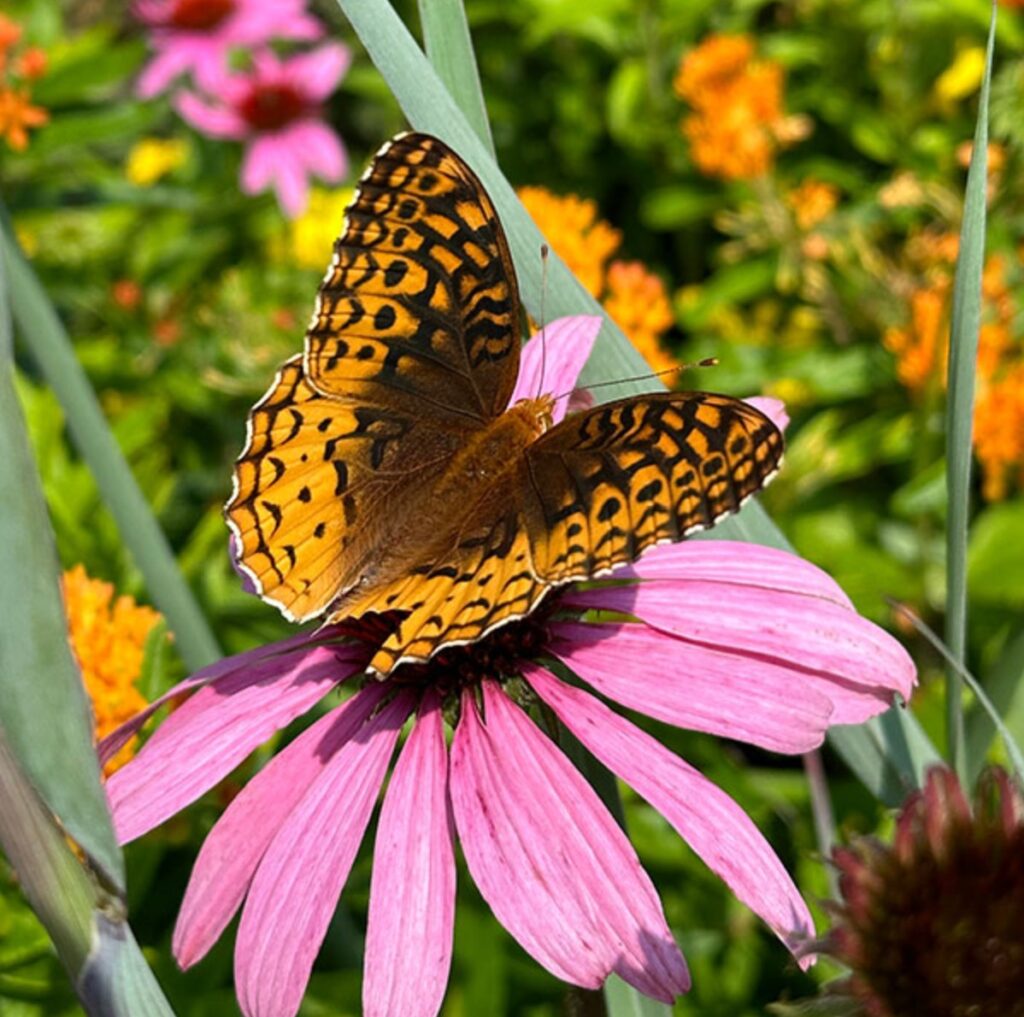If you’ve spent any time enjoying NEPA’s vibrant, colorful spring flowers, you’ve got a native pollinator to thank. All spring and summer, our birds, bumblebees, butterflies and beetles go to work to keep NEPA in bloom.
DiscoverNEPA is partnering with North Branch Land Trust, a nonprofit that conserves the natural, working and scenic landscapes of NEPA. They’ll provide conservation tips and give us a look at their protected lands. Learn how you can join NBLT and do your part to protect NEPA’s natural resources.
April’s rain and rising temperatures allow our native pollinators to emerge and our native plants to grow. Spring is the season of regrowth, however with the incredible work from our native pollinators, gardens grow, meadows flourish, and wildflowers blossom. When you find yourself walking around outside, a native Pennsylvania pollinator may greet you by flying past your eye and grabbing your attention. Follow it and see where it lands.
Great Spangled Fritillary on a coneflower. Photo courtesy of Leah Malarkey.
What is the first species you think of when you hear the word, “Pollinator”?
If you said, honeybee, you’re with the majority. However, while we have recognized honeybees as a major pollinator, they are not native to Pennsylvania or even the United States. These cute hairy bees are European honeybees. They were introduced to the United States in the early 1600’s, to source honey. These small, yet powerful bees can be competitors to our native pollinators to collect nectar and pollen, due to their large colony sizes. Honeybees are susceptible to a wide variety of diseases that spread easily. Xerces Society for Invertebrate Conservation, states. “Deformed wing virus can be passed from honeybees to bumble bees and can also amplify and distribute diseases within a bee community”.
So, who are some of our native pollinator species?
- Bees: Bumblebees, Carpenter Bees, Mason Bees, and Sweat Bees
- Butterflies: Monarchs, Eastern Tiger Swallowtails, and Great Spangled Fritillary
- Birds: Ruby-throated Hummingbirds, Goldfinches, and Orioles
- Beetles and flies are pollinators of Pennsylvania, too! When you stop and smell a flower, try to remember how our pollinators created the beauty we see and the food we eat.
A Goldfinch on a coneflower. Photo courtesy of Leah Malarkey.
Look for native pollinators in the wild
If you have a yard that doesn’t allow for plant growth, there are many places you can visit to see native pollinator gardens.
North Branch Land Trust’s George and Lillian Picton Wildlife Sanctuary, has a pollinator garden full of native plant species.
The Susquehanna Riverlands in Berwick has a pollinator garden that greets you once you arrive. If you walk up quietly, you may be able to spot native pollinators getting nectar from a wide array of flowers.
However, even on a walk on the Luzerne County Levee Trail, through the woods, or around your neighborhood, you can spot bees, butterflies, and beetles, who are carrying and spreading pollen.
Eastern Tiger Swallow at work. Photo courtesy of Leah Malarkey.
Unfortunately, our native pollinators need help
Many of their nesting sites, pollinating flowers, and breeding locations have and continue to be affected by habitat loss, environmental conditions and chemical sprays. These issues are directly impacting native plants too.
There are many ways to help our native pollinators. No help is too small.
If you have land:
Leave fallen leaves on the ground
- Fallen leaves create safe habitats for pollinators to survive through the cold winter months.
- In the spring, these leaves provide important nutrient rich food sources for our pollinators and enhance the soil with nutrients to aid with growing seasons.
Plant diverse group of native plant species
- Native plants are perfect as host plants for native pollinators (example: milkweed is a host plant for monarch butterfly caterpillars).
- Plant biodiversity allows for a healthy ecosystem that can support a wide range of native pollinators with year-round food and nesting sites
Reduce pesticides and insecticides
- These harmful chemicals don’t just cause harm or damage to our pollinator populations, but also other species that land on or even eat native plants / pollinators.
- Native plants require less pesticides by acclimating to its natural environment, by attracting mostly all native insects.
If you still want to help support pollinators but don’t have an area of land, you can:
Get involved
- Many non-profit organizations, conservation organizations, and environmental organizations will offer volunteer opportunities to assist with planting seeds or selling native plants.
Attend local educational events
- There are opportunities when organizations will host events that support pollinators, by informing the public on how to safely care for native plants and/or pollinators.
Share information
- When trying to help conserve or protect land, water, or wildlife, there is no such thing as “not doing enough”. Educating others on how to help our environment can be the start of many new beginnings. So, make sure you share new information with friends, families, and people you meet on how to protect and save our pollinators.
About Leah Malarkey
Leah implements environmental education programs at North Branch Land Trust for children and adults of all ages, that focus on the conservation of our environment. Creating art using media forms, traveling with her partner, and spending time outside are some of Leah’s favorite off work activities. Leah’s philosophy for conservation and environmental education is, “You cannot appreciate or feel the need to protect the environment without being fully immersed in it.”
